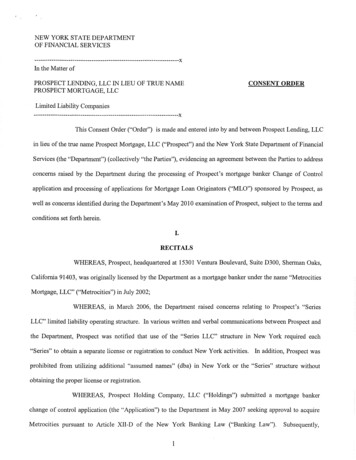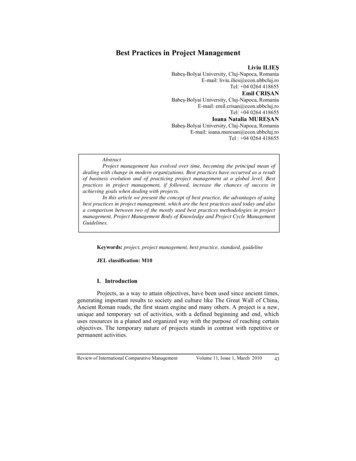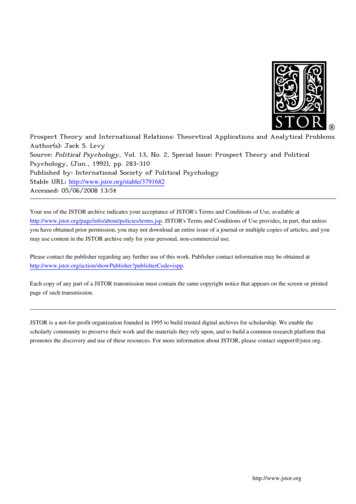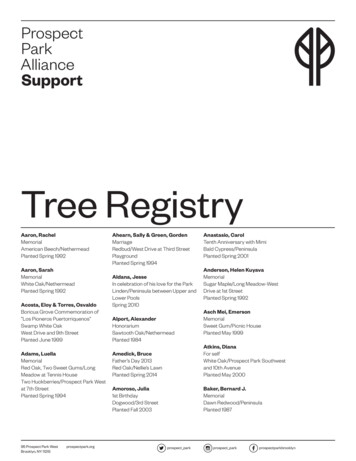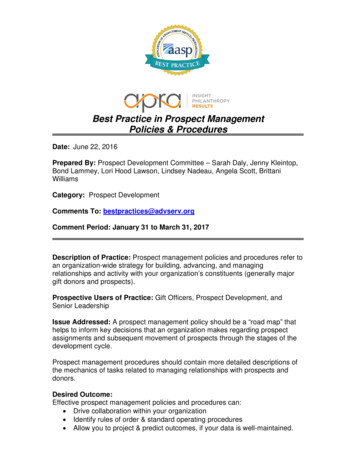
Transcription
Best Practice in Prospect ManagementPolicies & ProceduresDate: June 22, 2016Prepared By: Prospect Development Committee – Sarah Daly, Jenny Kleintop,Bond Lammey, Lori Hood Lawson, Lindsey Nadeau, Angela Scott, BrittaniWilliamsCategory: Prospect DevelopmentComments To: bestpractices@advserv.orgComment Period: January 31 to March 31, 2017Description of Practice: Prospect management policies and procedures refer toan organization-wide strategy for building, advancing, and managingrelationships and activity with your organization’s constituents (generally majorgift donors and prospects).Prospective Users of Practice: Gift Officers, Prospect Development, andSenior LeadershipIssue Addressed: A prospect management policy should be a “road map” thathelps to inform key decisions that an organization makes regarding prospectassignments and subsequent movement of prospects through the stages of thedevelopment cycle.Prospect management procedures should contain more detailed descriptions ofthe mechanics of tasks related to managing relationships with prospects anddonors.Desired Outcome:Effective prospect management policies and procedures can: Drive collaboration within your organization Identify rules of order & standard operating procedures Allow you to project & predict outcomes, if your data is well-maintained.
AASP Recommendation: A policy should be vetted by a task force consisting ofgift officers, donor relations, prospect development, advancement services, andsenior leadership. As the policy is rolled out, it should be clear that it has beenendorsed by senior leadership and that leadership holds staff accountable forcomprehension and compliance with the policy and related metrics.If rolling out for the first time, develop an implementation plan including trainingsessions and clear guidelines and expectations of gift officers. Onceimplemented, it should be reviewed and updated as necessary on an annualbasis or as significant changes occur.The policy should be no more than 12 pages in length, with an optional one-pageoverview that includes the basic information.The procedure document can be more detailed, including screenshots from thedatabase, forms and templates, and a glossary of key terms. It should bedeveloped in partnership with your organization’s database training team or othercolleagues from advancement services, as appropriate. Advancement servicesand prospect development should collaborate annually to review the proceduredocument and make necessary updates.Key sections of the policy document should include:I.Introductiona. Guiding Principlesb. Database of Recordc. Authority of PolicyII.Development Officersa. Roles and Responsibilitiesb. Portfolio Sizec. Prospect Contact Guidelines, Unassigned Prospectsd. Prospect Contact Guidelines, Assigned Prospectse. Conflicts and AppealsIII.Initial Prospect Assignmenta. Assignment Criteriab. Storage of Assignment Datac. Frequency of Prospect AssignmentIV.Prospect Actions and Contact Reportsa. Activeb. Passivec. Recording Data PointsV.Solicitationsa. Recording Data Pointsb. Clearance by Gift Sizec. Alignment by Prospect Stage
VI.Portfolio Managementa. Definition of Stagesb. Request Assignmentc. Prospect DisqualificationVII.Prospect Reassignmenta. Reassignment Scenariosb. Storage of Previous Assignment Datac. Frequency of Prospect ReassignmentVIII.Prospect and Pipeline-Focused Meetingsa. Portfolio Reviewsb. Prospect Strategyc. Solicitation PipelineIX.Metricsa. Visitsb. Solicitationsc. Dollars Raisedd. Qualificationse. OtherX.XII. Privacya. Industry-Established Ethics Policiesb. InternalXI.XIII. Definition of Key TermsXII.Sample Prospect Management ReportsSample Policies & Procedures/Resources:
Prospect ManagementGoalAt The Ohio State University, we believe that effective prospect management enables us to raise more money.Successful prospect management creates loyal donors that will give again.Guiding PrinciplesThis policy is built around the following guiding principles: Effective prospect management is a team activity which involves Advancement, academic leadership,faculty, physicians, volunteers, and others. Openness and trust between colleagues are critical. Successful prospect management requires a commitment to understanding all of a prospect’s passions,values, connections, giving history, and more. Prospects have complex, multiple philanthropic intereststhat may evolve over time, and may or may not reflect the university area(s) with which they wereoriginally affiliated. The very best donors have multiple points of engagement at the university. Prospect Managers,regardless of assignment or area, coordinate relationships with all relevant areas of the university andmatch the prospect’s philanthropic interests with institutional priorities and funding opportunities. All university staff use The Advancement System (TAS) to coordinate and document philanthropicrelationships, including all qualification, cultivation, solicitation, and stewardship activities. Policies andprocedures are clear, coordinated, and transparent.University ValuesOur prospect management program and our interactions with each other reflect our shared university values:ExcellenceCollaboration as One UniversityActing with Integrity and Personal AccountabilityDiversity in People and IdeasChange and InnovationSimplicity in WorkEmpathy and 4.247.1535
Roles and ResponsibilitiesA. Prospect ManagerThe Prospect Manager (PM) is the person most directly responsible for coordinating the relationship between aprospect and the university. At all times, the PM must take into account the prospect’s interests and the needsof the university.The Prospect Manager is responsible for: Engaging prospects by connecting them with appropriate university partners, areas, and activities Being knowledgeable about prospect interests and university priorities Collaborating with university partners based on the prospect’s passions and the university’s priorities Developing and executing thoughtful plans with strategic steps that result in successful solicitations Documenting interactions, plans, and outcomes in TAS for the benefit of the life-long universityrelationship Leading team meetings and strategy planning sessions where multiple interests or complex planswarrant Communicating regularly with assigned prospects and university partnersThere is only one Prospect Manager assigned per Prospect.B. Prospect TeamThe PM will coordinate efforts of a prospect team comprised of additional front-line fundraisers, administrators,faculty, staff, and volunteers. These individuals work with the PM to cultivate the university’s lifelongrelationship with the prospect. Secondary managers include fundraisers, administrators, faculty, staff, andvolunteers assisting with solicitations, stewardship, research, and other activities.There may be zero, one, or many secondary solicitors assigned in a prospect plan at any given time, and theindividuals and roles represented may change over time. The PM is responsible for ensuring that all relevantpartners are appropriately recorded.AssignmentA. Initial Qualification and AssignmentFundraisers may request to be assigned as Prospect Manager (PM) for an unassigned constituent by completingthe following: Qualification of the constituent as a prospect for Ohio State Providing an initial strategy focused on obtaining a gift Documenting all qualification workB. QualificationQualification is the process of confirming a constituent’s capacity, interest, and inclination to make a gift to OhioState.prospectdevelopment@osu.edu2614.247.1535
Qualification is most frequently accomplished through direct interaction with the constituent, but may alsoinclude information from peers, volunteers, or others with personal knowledge of the constituent’s capacity andinclination to give to Ohio State.The preferred method of qualification is a completed Personally Scheduled Meeting (PSM) with the constituent.Other contact methods may be acceptable and will be reviewed on a case by case basis.In some situations, it may be appropriate for one fundraiser to complete qualification work and then identifyanother fundraiser as PM (in the same or a different unit). This is likely when qualification identifies a strongprospect interest in a unit different from initial expectation and/or a better match is identified within the sameunit.C. Requesting AssignmentA formal request for assignment is submitted by completing the “Request prospect assignment” task in TAS. Allqualification interactions must be documented in TAS prior to requesting assignment.At the time of request, the fundraiser is expected to provide information including strategy, ratings, fundinginterests, and additional team assignments. This is in addition to the previously documented qualification work.D. Referrals from Research, Physicians, Faculty, Volunteers, or Other University StaffLeads provided by Prospect Research, as well as referrals from physicians, faculty, staff, or volunteers, need tobe qualified by a fundraiser as described above.E. Corporations and FoundationsIn the event assignment is requested to an individual in a leadership position at an assigned corporation orfoundation, the Corporate and Foundation Relations Office will be consulted to determine if this will createconflict. The same applies for requested assignment to organizations with assigned leaders.F. Spouses and Domestic PartnersWhen a PM is assigned to a prospect, the default action is to link the prospect’s spouse or domestic partner in aprospect group and assign the group to that PM.An exception may be made if the prospect and their spouse/domestic partner do not make giving decisionstogether. In this case, dual PM assignment (in which a PM manages the prospect and another PM manages thespouse/partner) may be warranted. Dual assignment can be requested directly from the Office of ProspectDevelopment; senior leadership may be consulted before dual assignment is approved. When dual assignmentis approved, each PM will be listed in a secondary role on the corresponding spouse/partner record.Spouses who are alumni of different areas are not justification for dual assignment.G. Prospect Manager EligibilityOnly personnel (specifically, Advancement Officers, Development Officers, or Stewardship Officers) who reportdirectly or indirectly to the Senior Vice President for Advancement are eligible to be PM. AdditionalAdvancement staff, academic leadership, faculty, physicians, volunteers, and others are critical to the success ofprospectdevelopment@osu.edu3614.247.1535
prospect management and may be formally assigned in other roles. Potential exceptions to these standards willbe reviewed on a case-by-case basis and are approved by the Director of Prospect Development.H. Assignment TransitionA transfer of assignment may occur when warranted by the prospect’s capacity or interests, or by staff changeswithin a unit.Transfers can be made by notifying the Office of Prospect Development.I.Departing StaffWhen a departing staff member gives notice, the supervisor should immediately schedule a portfolio reviewwith the departing staff member. In this review, existing assignments and high priority prospects and stepsshould be discussed and recommendations made about temporary or permanent transfers. Prospects suitablefor dismissal from prospect management should also be identified.The supervisor of the departing staff member is responsible for providing a list of recommended temporary andpermanent reassignments and dismissals to the Office of Prospect Development by the date of the staffmember’s departure. Recommendations will be reviewed by the Office of Prospect Development and the Officeof the Senior Vice President, as appropriate, prior to reassignment.J.Transparency of Assignment and TransferAll new assignments and transfers will be included in a weekly list distributed to all Prospect Managers.Prospect PlansThe PM is responsible for coordinating any and all prospect plans on the prospect record. Prospect planscontain a record of all steps, solicitations, and prospect team members involved in the prospect relationship.Portfolio StandardsA. Portfolio SizeA standard portfolio for fundraisers should consist of up to 75 prospects to whom fundraisers are assigned asProspect Manager (PM). This limit includes PM assignment to prospects in active and stewardship statuses, andprospects may be added or removed from the portfolio as long as the limit of 75 prospects is not exceeded.Variances in portfolio size may be granted based on unit priorities, allocation of time spent fundraising, the leveland maturity of prospects/donors, and program specialties (e.g., annual giving, gift planning, corporate andfoundation relations, etc.) Requests for portfolio variances are reviewed by appropriate senior leadership.B. InactivityProspects without any documented significant contact in 12 months are considered unmanaged and will beremoved from the PM’s portfolio. Significant contact is defined as documented interaction with contactmethods of face to face or a personally scheduled meeting.prospectdevelopment@osu.edu4614.247.1535
Active prospects (non-stewardship) that are not moved from one stage to another within 12 months areconsidered unmanaged and will be removed from the PM’s portfolio along with related plans and opportunities.Prospects removed from a portfolio due to inactivity can be re-qualified at a later date according to normalstandards and requirements.Contact ProtocolsEvery staff member must file an interaction for any significant contact with a constituent in accordance with theInteraction Guidelines. Advancement staff members are responsible for ensuring that all significant contactfrom their faculty, deans and volunteers are documented in TAS.A. Unassigned ConstituentsAny fundraiser may contact unassigned constituents in order to assess their interest in a particular area and tobegin the cultivation process. Fundraisers are responsible for reviewing a constituent’s Interactions page in TASprior to initiating contact to determine if recent contact has been made and/or qualification work is alreadyunderway.B. Assigned ProspectsA critical component of prospect management is strong, clear coordination of communication, strategy, andsolicitation – a primary responsibility of the Prospect Manager (PM). To that end, the following contactprotocols are in place for all assigned prospects.It is every fundraiser’s responsibility to confirm assignment of any constituent in TAS prior to initiating contact.In all instances, a fundraiser must contact the PM prior to contacting an assigned prospect.The PM is expected to respond to a contact request from another fundraiser in 2-5 business days. If there is noresponse in that time period, the matter may be resolved according to the Conflicts & Appeals section of thispolicy.If a prospect initiates contact with a fundraiser that is not the PM, the contacted fundraiser should notify the PMas soon as possible after the contact (in addition to filing an interaction in TAS) and ensure that futureinteractions are coordinated.The following exceptions do not require advance notification of the PM: Membership/program renewals such as Alumni Association, Buckeye Club, President’s Club, WexnerCenter for the Arts, WOSU, etc. Athletics ticket renewals Board/committee meetings for existing appointmentsThe PM may determine that new contact is inappropriate when any of the following situations occur: An expected ask date in a documented prospect plan is within 90 days A formal solicitation has been made and response is pending The prospect has specified limited or no contact, due to life events and/or non-interest in programs (or,alternatively, the PM knows of life events that make contact inappropriate) The prospect has had frequent and recent interaction from the university in the last 3 monthsThe PM may determine that, even in these situations, contact is permitted.prospectdevelopment@osu.edu5614.247.1535
Otherwise, any fundraiser may contact the prospect after first consulting the PM to ensure coordination ofactivities.Prospect StagesProspect stages form the pathway through which a PM develops and advances the prospect’s relationship withOhio State and moves a prospect toward making a gift.Prospects move through stages each time a new solicitation is desired. At times a prospect may skip stagesdepending on how the plan advances.Prospects are typically expected to move through the stages within 18 months, although the Stewardship stagemay last significantly longer. Variation around this timeframe may occur depending on the type of gift beingsolicited (e.g., annual gift, planned gift, principal gift) or the type of prospect (e.g., grateful patients,corporations, foundations).StagePlan StrategyCultivationReady to SolicitGift inNegotiation/ClosureStewardshipPurposeTo further engage, inform, orget to know the prospect viainteractions that move theprospect toward the next stage.To deepen engagement andcultivation via substantiveactions in order to furtherdetermine prospect interestsand match them withinstitutional need (preliminarygift discussion).PM and partners determine ifthe prospect is ready to receivea proposal.To continue involvement withthe prospect while preparing toformally solicit.Primary manager finalizessolicitation (solicitor, date,amount, designations, etc.)To continue to interact with theprospect to finalize the gift;revise gift details as needed.PM ensures the gift isacknowledged and stewarded.PM determines donor’sstewardship on steps are developedand recorded in TAS plan.3 monthsInteractions occur that move theprospect into active cultivation.Interactions occur that move theprospect closer to solicitation.Clearance to solicit is requested ifask amount is 1M (in whichcase approval is required beforenext stage).9 monthsSolicitation steps and opportunitydata are recorded in TAS.Solicitation is made.3 monthsGift is closed, documented, andrecorded in TAS.3 monthsPM retains assignment for donorswith active prospect status; a newopportunity may be entered in TAS.A shift to a stewardship status maybe appropriate, as indicated inStewardship section of this policy.6Duration3-5 years forfuture gift fromdonors withactive status.614.247.1535
Clearance to SolicitAny solicitation of 1M or more must be approved by the Office of the Senior Vice President for Advancementprior to soliciting the prospect. 1M opportunities will be reviewed every two weeks. If a gift discussionadvances more quickly than anticipated and/or the original expected ask amount suddenly moves above 1M,the PM will notify the Office of the Senior Vice President as soon as possible.StewardshipStewardship is the comprehensive effort to ensure donors experience high-quality interactions with Ohio Statethat reinforce the impact of their generosity and foster long-term engagement and ongoing investment.Stewardship sets the stage for future solicitation.A. Stewardship StatusA prospect’s stewardship status is determined by the donor’s ability to make a gift in the future. The decision tomove a prospect into a stewardship status can be made once a gift is received and the donor is not expected toimmediately enter cultivation for the next gift.Active Stewardship Status – Donors who have made a gift to Ohio State and retain thecapacity/inclination to make another gift to Ohio State in 3-5 years.Legacy Stewardship Status – Donors who are not likely to make another major gift to Ohio State; theymay retain the capacity/inclination to make a future gift to Ohio State, but who are believed to not be inActive Stewardship Status.The Prospect Manager (PM) is responsible for managing the prospect plan and notifying the Office of ProspectDevelopment when a change in status is needed.Movement from either stewardship status back to an active prospect status may occur when circumstances aresuitable (i.e., there are clear indicators that a new gift conversation is appropriate).B. Stewardship RequirementsFor any donor in a stewardship status, the PM ensures: The prospect plan is actively managed and documented in TAS, with one or more appropriatefuture/pending stewardship steps. The donor is managed and contacted according to the standards of assigned prospects detailedelsewhere in this policy.Accountability, Supervision, and PerformanceSupervisors will use reports, including information about contact activity, portfolio composition, proposalssubmitted, and proposals closed, in order to evaluate the performance of fundraisers. Specific goals forfundraiser performance will be set by individual managers, based on job descriptions and organization metrics.Supervisors are required to review their staff’s new and moving proposals at least quarterly to assure progresstoward a gift decision.prospectdevelopment@osu.edu7614.247.1535
Conflicts & AppealsIn all matters of assignment and activity coordination, common sense and courtesy shall be the prevailingguideline.Any fundraiser may request a review of the following: Prospect Manager assignment Prohibition to contact or solicit Inactivation of records showing no contact or moves within 12 months Disagreements among fundraisers (or their volunteers or staff) regarding a specific donor or strategyWhere differences of opinion occur, staff members are expected to use the following process to resolveconflicts:1. Contact and as needed meet with all interested parties to address and resolve the issue.2. If consensus is not reached through this process, then the issue should be presented to the fundraiser’ssupervisor, who will work with other relevant supervisors and the Director of Prospect Development tohelp facilitate a resolution.3. If the conflict cannot be resolved in this fashion, the Director of Prospect Development will bring theconflict to senior leadership who will make the final determination.Policy Management and OversightThe Director of Prospect Development manages and administers current prospect management policies,procedures, and any future revisions on behalf of the Office of the Senior Vice President for Advancement.ContactFor assistance in interpreting and applying this policy, please contact the Office of Prospect Development:prospectdevelopment@osu.edu 614.247.1535Revised 2/16/2016 10:37 AMprospectdevelopment@osu.edu8614.247.1535
Plan Steps and Interactions: GuidelinesWhat is the difference between a plan step and an interaction?Plan steps and interactions are very similar. The major differences between them are who gets them, and wherethey are entered.Plan steps are used for managed prospects. There are special data fields within steps that contain informationspecific to prospects; they are entered from within a prospect plan.General interactions are used for constituents who are not managed prospects. They are entered from theconstituent’s general interaction page.What is a step/interaction?An individualized and meaningful activity with any constituent in which new information is obtained and/orthat moves Ohio State’s relationship forward (as it relates to giving, engagement, etc.) constitutes an interactionthat should be filed in TAS.Individualized means the activity was specific to the constituent, and not an event, form letter, or broad appeal.Meaningful means the activity resulted in new knowledge about the constituent and/or relates to a strategy,gift conversation, gift negotiation or gift stewardship. When a colleague (or your future self) reads this they willget value from it.How quickly should a step/interaction be filed?All steps or interactions should be entered in TAS within one week of the activity.On which records should I enter the step/interaction?As noted above, plan steps are entered on the prospect record, from within a prospect plan. The best way forfundraisers to access plans and plan steps is from their fundraiser page.General interactions for individuals should be entered from the constituent’s individual record. In cases wheremore than one constituent was involved in the activity, additional individuals should be listed under“Participants.” In most cases, there should not be multiple interactions filed for the same activity.When entering a contact with a representative of an organization, enter the activity from the organization’srecord. For example, if you met with Jane Doe to discuss Company X, file the interaction on Company X’s recordand include Jane Doe as a 35
What should NOT be filed in TAS as steps/interactions?EventsThank-you letters or form lettersBoard, committee, and volunteer meetingsGroup solicitations and appeals (to more than one individual, at any dollar level)Cards and notes for holidays and special occasionsRandom friendly encounters where nothing new is learned nor is the relationship advancedMeetings with administrators, faculty, physicians, etc. that do not directly cover their personal philanthropyThere are special ways in TAS to track events and group communications: For events not managed by Advancement Events, email the Customer Service team atcustomerservice@ohiostatealumni.org for assistance in documenting attendance. For group communications, email bioupdate@osu.edu for assistance in documenting these contacts inTAS.Specific Guidelines for Events, Suite Attendance, and Board/Committee MeetingsAny activity with 10 or more constituents should be documented as an event, not a step or interaction. Thisincludes: events such as receptions and dinners; suite attendance at athletic events, concerts, or shows; orboard/campaign committee, or volunteer meetings.You may have a meaningful one-on-one conversation or stage movement with an attendee at an event. In thiscase, you should file an additional step or interaction for only that attendee on his/her record; the contact typethat should be used is (by definition) Face-to-Face. Steps or interactions at events of any type are not PersonallyScheduled Meetings.What if there are multiple contactors?Many steps and interactions will have multiple individuals representing OSU, such as DOs, deans, directors,volunteers, and other staff. In these situations, one single step/interaction should be filed with all additionalpersonnel listed as additional contactors/solicitors.All contactors are responsible for coordinating single entry of the step/interaction in TAS. (The primary/ownermay add the interaction to TAS and others can review and make additions, if desired.)Content Guidelines: Summary/ObjectiveUseful summaries explain purpose and/or outcome, who was visited by whom and where, and what wasdiscussed. Date and contact methods are not necessary, as they are collected in another field. If an ask wasmade or a gift was presented, be sure that is clear in the title.Examples of complete summaries include: Met with Logan and asked for 1M gift for cancer research support Dinner with Joe Steinmetz and OSU alumni to discuss fundraising for Ottoman and Turkish Studies Discussion and planning for event in Palm Beach hosted by Peter and Mary Jane Cultivation visit to determine interest in supporting Engineering programs Dr. Smith was asked and agreed to an 80K gift to support Ross HH Medical Director Fundprospectdevelopment@osu.edu2614.247.1535
Hosted Lois at KSA and CEG for facility toursTony joined Drs. Abraham and Mazzaferri to hear an update on his gift to CardiologyScott emailed with questions about draft of ME gift agreementExamples of incomplete summaries include: Met for dinner PSM with Mark PSM lunch at Rusty Bucket Chicago trip Greeted during visit to basketball suiteContent Guidelines: CommentsThe text should be concise and reflect the actual account of the contact. Steps and interactions should includenot only a statement of purpose, but also a summary of what was learned.Tips for creating useful contact report text: Lead with a concise summary statement such as “The purpose of the contact was .” Include a conclusion such as “The result of the contact was ” or “I learned ” Describe who was meeting with whom (including full names and titles), where the meeting took place andthe purpose of the meeting. Describe the topics of discussion and what various participants contributed to the discussion. Note and account for donor likes, dislikes and statements regarding their affinity to Ohio State, politicalstatements, passion statements along with information on key relationships and biographical updates. If an ask was made or answered, be sure to include the amount, designation(s), initial or formal response,anticipated response date, and timeline for follow-up. Describe qualifying information: Family (members, size, structure, relatives, situations) Assets (hard, soft, liquid, investments, properties) Values (social, personal, other issue areas) Advisors (personal or professional) Motivations (projects, involvement, beat areas, experiences, passions) Career Information (where, what and for how long)End with your overall summary of the contact and next steps.Guidelines: Contact MethodsAttempt(s) to ContactOne or more unsuccessful attempts to contact a prospect; may be asummary of attempts over multiple dates.ElectronicPersonal one-on-one electronic correspondence, such as email or textmessages, where targeted and/or substantive information is exchangedbeyond casual conversation.Face to FaceA one-on-one interaction with the constituent; face to face interactionsare unplanned and/or occur at events, meetings, etc.; substantiveinformation is exchanged beyond casual 535
Internal MeetingAn internal meeting is held to discuss business and/or strategy related toa constituent and the constituent is not present.L
Prospect management procedures should contain more detailed descriptions of the mechanics of tasks related to managing relationships with prospects and donors. Desired Outcome: Effective prospect management policies and procedures can: Drive collaboration within your organization Identify rules of order & standard operating procedures
